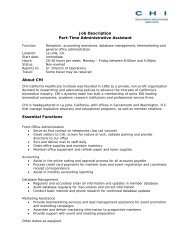California Biomedical Industry - California Healthcare Institute
California Biomedical Industry - California Healthcare Institute
California Biomedical Industry - California Healthcare Institute
You also want an ePaper? Increase the reach of your titles
YUMPU automatically turns print PDFs into web optimized ePapers that Google loves.
of data and knowledge that will shapebreast cancer care in the way therenowned Framingham heart studychanged the care of patients with heartdisease.The ATHENA project is headed byprincipal investigator Laura Esserman,MD, MBA, professor of surgery andradiology, director of the UCSF CarolFranc Buck Breast Care Center andco-leader of the breast oncologyprogram at the UCSF Helen DillerFamily Comprehensive Cancer Center.In addition to compiling essential andunprecedented data from breast cancerpatients, the collaboration of UC’s fivecancer centers also enables them tomore easily conduct breast cancer trials.Using a common information centerand one investigational review board(IRB), the coalition is more attractive totherapeutic developers seeking clinicaltrial investigators. The arrangementalso enables the UC cancer centers tomore quickly identify trial candidatesand to place their patients intoinvestigational new drug programs theymight not otherwise learn about.“We are looking at using the multicampusapproach to conducting clinicaltrials in other specialty areas,” Stobosaid, “and at whether a system-wideIRB would make sense.”In the biomedical arena, Tucker said,key initiatives include incubators —structured arrangements that enablefaculty, graduate students and postdoctoralfellows to begin the processof transforming their early stagediscoveries into marketable products.From providing lab space and accessto university equipment to connectingwould-be entrepreneurs with theinvestment, business and legal mentorsthey would need to succeed, U.S. ispaving the path to business formations.In a related area, Tucker said that somediscoveries require more testing to bemade attractive to industry. “We arestarting a ‘proof-of-concept fund,’” hesaid, “to facilitate tech transfer by takingideas with market potential to the nextlevel.” Demonstrating that a basicresearch discovery offers measurablebenefits would make the intellectualproperty more attractive and valuable topotential partners. Tucker added that bycreating a comprehensive database ofthe discoveries available for technologytransfer across the system, we hope toalso accelerate transactions.Tucker said that the UC systemalso is investigating and comparingbest practices in other states to findnew avenues to pursue for revenue,grants or other funding. He said thatincentives have been instituted inWisconsin, Minnesota and other statesthat give taxpayers — individuals andcorporations — tax credits for investingin their state’s emerging biomedicalcompanies. The approach providessmall companies with more moneyto invest in technology transfer fromuniversities and research centers.Both Stobo and Tucker are proponentsof reevaluating the UC system’s role inthe state’s economy, service structureand still-growing innovation legacy.“We need to have a fundamentaldiscussion, involving industry,government and universities, about thekey societal functions of each,” Tuckersaid. The three entities all impactemployment, healthcare, education, andquality of life, each working in their ownway. “We need to create places wherewe can meet and talk at C-levels aboutwhat each brings to the table and to besure that, at the least, we are not puttingobstacles in one another’s way.”<strong>California</strong> <strong>Biomedical</strong> <strong>Industry</strong> 2011 Report | 57






